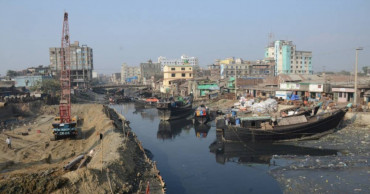Buriganga Pollution
250 untreated sewage connections polluting Buriganga!
Around 250 pipelines are discharging raw sewage directly into the Buriganga River within a span of only six kilometres, contributing to 30-40 percent of the pollution in one of Bangladesh’s most contaminated rivers.
A recent study has revealed that untreated sewage is being released through 251 pipelines, from Sheikh Russel School in Kamrangirchar to Farashganj Bridge.
The study, titled “Pollution Status of Dhaka Rivers” and conducted by the River and Delta Research Centre (RDRC), found 137 sewage lines on the left bank (Old Dhaka) and 114 on the right bank (Keraniganj side).
According to Mohammad Azaz, RDRC chairman, the sewage connections were identified through a field-level investigation.
Lead pollution: Despite ranking 4th in world, awareness in Bangladesh alarmingly low
He suggested that these pipelines could be diverted to the Pagla Sewage Treatment Plant (STP) with a small-scale project costing only Tk 25-30 crore.
“If the 251 sewage connections can be stopped, it would be possible to check 30-40 percent of pollution in Buriganga River,” Azaz stated.
Prof Ahmad Kamruzzaman Majumder of Stamford University’s Environmental Science Department cited untreated sewage discharge, industrial discharge, waste dumping points and discharge from water vehicles as the primary sources of pollution in the Buriganga.
He stressed that without controlling the sewage discharge, the river’s water could never be clean or usable.
The environmentalist suggested establishing small to medium sewage treatment plants (STPs) in various locations to manage the raw sewage from these connections effectively.
Prof Majumder noted that during the June-September period, certain parameters of the Buriganga’s water quality remain within or close to the national standards set by the Department of Environment. However, in other periods, the water quality consistently exceeds permissible levels.
Dhaka’s air pollution reaches alarming level: Research
The study also highlighted that 257 waste dumping points along the river banks are contributing to the pollution of the Buriganga River, with 148 located on the right bank and 109 on the left.
Besides, untreated effluent from industrial outlets is being discharged at 93 locations, with 35 points on the left bank and 58 on the right.
The study also identified additional pollution sources in nearby rivers, finding 99 untreated sewage connections to the Turag River and 10 to the Balu River, along with 131 waste dumping points along Turag, 51 in Tongi Khal and 32 in Balu.
Azaz pointed out that Turag provides 90 percent of the water flow into the Buriganga, but the Turag itself is being contaminated at various locations, particularly in Gazipur.
He urged the government to formulate a comprehensive action plan to eliminate untreated sewage connections and waste dumping along the Buriganga and Turag rivers to restore the Buriganga to its natural state.
According to the World Health Organization (WHO), the Buriganga is among the most polluted rivers globally, with more than 60,000 cubic metres of toxic waste dumped daily into its waters by the city.
1 year ago
Buriganga Pollution: Contempt rule issued against Wasa MD
The High Court on Thursday issued a contempt of court rule against Dhaka Wasa Managing Director Taskim A Khan.
5 years ago



